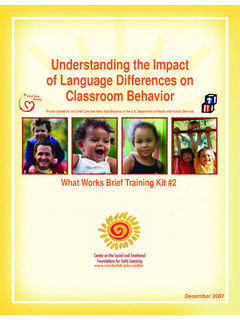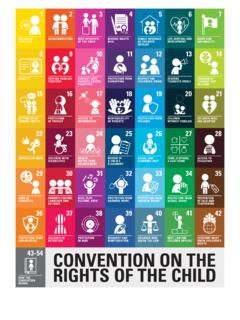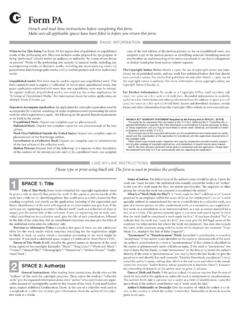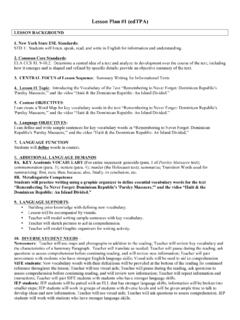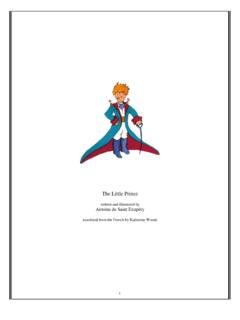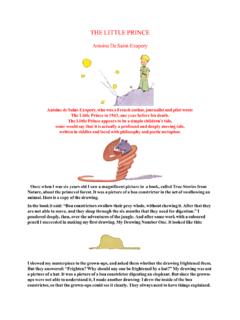Transcription of Interpreting Childrens Human Figure Drawings
1 Interpreting Children's Human Figure Drawings Interpreting Children's Human Figure Drawings : Basic Guidelines for School Counselors Yuehong Chen Foley Fran Mullis Yuehong Chen Foley, , is a Behavior Interventionist at Cedar Hill Elementary School, Gwinnett County Public Schools in Lawrenceville, GA. The literature was reviewed and summarized to provide common interpretations of Human Figure Drawings . Basic guidelines for Interpreting Human Figure Drawings ( , face and head, body, arms and hands, and legs and feet) are presented. Expectations for students at different de velopmental levels (ages 1 Y2 through adolescence) are identified, and the influence of artistic ta le nt is discussed. Two children's Drawings from case studies in a school setting are interpreted. Ethical considerations such as privacy, confidentiality, displaying Drawings , and keeping Drawings for documentation are summariz ed. In terpreting Children's Human Figure Drawings : Basic Guidelines for School Counselors Many counselors and psychologists be li eve that all people conve y something of their emotional state whe n they draw a picture and that this information can be used in counseling.
2 Drawings can be used in school settings with stude nts who are struggling with normal developmental issue s. Children's Drawings are indicators of emotions, self-este em, and social competenc e, as well as other aspects of pe rsonality (Di Leo, 1973; Malchiodi, 1998), and are a way for children to call attention to topics that are personally importa nt or emotionally sig nificant (Thomas & Silk, 1990). Strong emotions emerge in the form of images instead of words (Kramer, 1973; Naumburg, 1973). Drawing allows students to experience rather than verbalize feeli ngs, and, therefore, may be more effective in helping children accomplish counseling goals (Withrow, 2004). Coleman and Farris-Dufrene (1996) found that children te nd to be receptive to art therapy, because art is one of a child's natural ways to engage in creative self-expression, to explore conflicts, and exercise control over perceived realities (Kramer, 1979; Naumburg) . Art activities provide a safe and enjoyable means that encourage children to explore, make decis ions, and solve problems (Allan, 1987), and provide a way for them to portray their inner world without having to rely on words (Gil, 2006).
3 Kaplan (2003) and Gil suggest that although research on art-based assessments is inconsistent, Drawings can help counselors increase their understanding of the clie nt, and Carmichael (2006) states that Drawings frequently are used as informal assessments for understa nding children's struggles and their internal world. Drawings also can be used to help the child gain insight and to review progress through drawing records (Withrow, 2004). Whe n a child transfers the picture in the mind onto a piece of pa per, the drawing becomes an external object that the child can use to gain control and mastery (Webb, 2004). Processing the meaning of the drawing may reinforce the child's self-exploration and motivation to cha nge (Rile y, 1994), and this effect may continue long after the counseling ends (Wadeson, 1980). An effective interpretation helps the child to accept the painful thoughts and feelings and resolve internal conf lic ts (Whitmont, 1969), allows the counselor to tentatively generate hypotheses for working with the child (Furth, 2002), and facilitates collaboration between counselor and child in exploring and understanding the meaning of the drawing (Crenshaw, 2006).
4 When students are referred to the school counselor because they are struggling academically, personally or socially, the counselor must quickly determine what the student is experiencing and decide how best to intervene. When the specific issue underlying the concern is difficult to assess, children's Drawings can be helpful in providing hypotheses. Interpretation is used only to generate hypotheses (Anatasi & Urbina, 1997; Gil, 2006; Gregory, 2000) rather than to diagnosis . As Anastasi (as quoted in Thomas & Silk, 1990) states, projective indicators such as Drawings "serve best in sequential decisions, by suggesting leads for further exploration or hypotheses about the individual for subsequent verification" (p. 116). Di Leo (1983) states that " Drawings are one means of establishing a rapid, easy, pleasant rapport with the child" (p. 4). Children who are shy, quiet, impulsive, have speech and language difficulties or speak a different language from the counselor usually respond well to drawing activities (Klepsch & Logie, 1982).
5 Drawing may be especially helpful when working with children from other cultures, because it allows children to communicate with others across barriers of language and culture and helps to establish understanding between themselves and adults (Cochran, 1996; Gil & Drewes, 2005). Gil and Drewes state that art activities are especially useful for some ethnic populations that prefer metaphors and symbols over verbal communication, and for children who may not be comfortable talking about experiences because of family messages or beliefs. The act of drawing can be therapeutic even if the child does not talk about the picture. Although art in general is less limited by cultural differences between counselor and client than talk therapies and interventions, Carmichael (2006) cautions that counselors need to be aware that some religions, such as Islam, prohibit children from drawing Human figures . Children from some Asian cultures are uncomfortable with drawing spontaneously and might prefer to begin by copying a drawing (Gil & Drewes).
6 It is important to encourage children to draw without violating their cultural or religious values. Although many school counselors have little or no training in art interpretation, they can learn basic guidelines for hypothesizing possible meanings behind wha t the student draws. A general understanding of the child's situation, affective expressions, and verbalizations, as well as the actual drawing, assis t in making an interpretation (Lenore, 1993). There are many types of Drawings ; however, only Human Figure Drawings are discussed in this article. Factors to Consider in Formulating Hypotheses Whe n making hypotheses about children's Human Figure Drawings , there are three areas for school counselors to consider: the student' s developmental level, his/her talent for drawing, and common interpreta tions of elements in a drawing. The Drawings described for each developmental leve l are examples of what healthy children would draw. Counselor s need to keep in mind that the deve lopmental levels may overlap with regard to age range and that children tend to fluctuate between the stage s (Malchiodi, Kim, & Choi, 2003).
7 Developmental Level One and one-half years to five years. At about 18 months of age, children begin to make marks on paper. Luquet (as cited in Thomas & Silk, 1990), and Piaget (as cited in Thomas & Silk) both regarded these early scribbles as pure play and exercise, rather than attempts to draw pictures . Usually around the age of2 or 3, this scribbling begins to be interpreted as a picture, although the child waits until the drawing is complete and then states what the drawing represents. People and animals are typically drawn us ing a tadpole schema, with a circle for the head or for the head and trunk, and two dangling lines for legs. Facial features and arms may be included, but the Figure has the look of a ta dpole. Children are unaware of color choices and typically use whatever color is close at hand (Malchiodi, 1998). Five years to eight years. According to Luquet (as cite d in Krampen, 1991) and Di Leo (1983), intellectual realism begins around 5 years of age.
8 During this stage, children draw what they know about reality and sometimes de pict the outside of a house, as well as what is inside the house, because they know that furniture and pictures are there, or they might show a person's arm even though it is hidden by the body. This type of drawing is called transparency or X-ray drawing (Di Leo, 1983; Krampen; Malchiodi, 1998) and might depict something that is not observable in the real world (Thomas & Silk, 1990) suc h as a bird with a worm in its stomach. Rubin (2005) states that around the ti me formal schooling begins, children find preferred ways of drawing things and repeat them. Children begin to connect color with wha t they see in the world around them, but it is difficult to know if the colors sele cted have a specific meaning, if they reflect wha t is seen in the environment, or if they indicate experimentation with different colors (Malchiodi). The scaling and details of pictures become more realistic during this stage.
9 Children typically stop drawing ta dpole Human figures and instead draw a head, a separate trunk, attached arms and legs, and de tails such as hands, fingers and clothing (Thomas & Silk, 1990). Children sometimes revert to earlier stage s and in the same picture might draw one person using a tadpole schema and another using a more advanc ed mode of representation. Eight years to adolescence. Luquet (as cited in Krampen, 1991) and Di Leo (1983) note that children at this stage produce visually realistic Drawings which correspond to the stage of concrete operations. Children be gin to use perspective and draw only what is visible from a certain point of view. For example, children would not draw the outside of a house and show furniture inside , because they know you cannot see furniture from the outside of a house. Children tend to develop rules for the use of color, such as brown or black for a tree trunk and green for the leaves. Unusual color use may have mor e significance at this stage than at earlier stages (Malc hiodi, 1998).
10 Many ele mentary school students willingly draw pictures at the request of a school counselor or other adult. Around 10 years of age, children begin to become dissatisfied, discouraged and self -critical with their drawing attempts, probably because they are unable to draw as well as they would like (Rubin, 2005). At this ti me, children tend to draw cartoon or comic-str ip characters, and their Drawings are somewhat stereotyped, or conventional (Thomas & Silk, 1990). Middle and high school students, as well as some older elementary stude nts, sometimes hesitate to draw because they doubt the ir artistic ability and are critical or self -conscious of their finished pr oduct (V~ Fleet, 2004). To encourage reluctant students to draw, Van Fleet sugge sts that school counselor s draw "goofy" art and invite the student to add to the drawing. According to Koppitz (1984), young teenagers who are language-impaired and view the visual-motor area as a strength, immature adolescents, and artistically talented adolescents continue to take pleasure in drawing.

